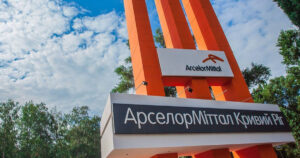
Sukha Balka mine (Kryvyi Rih, Dnipro region), part of Aleksandr Yaroslavsky’s DCH group, has commissioned a new block with iron ore reserves of 41.5 thousand tons.
As reported in DCH Steel’s corporate newspaper on Thursday, a new production unit was commissioned at the Frunze mine, which will ensure production in the coming months.
“On February 26, a new block 55-61 from the Druzhba deposit at the -1210-meter horizon was commissioned at the Frunze mine. The production capacity reserves amount to 41.5 thousand tons of high-quality raw materials with an iron content of 60% to 66%. Sinking and mining operations were carried out with the help of self-propelled equipment, while drilling was carried out using NKR machines. The extraction of raw materials is organized by a classic end-face production,” the information states.
The block’s reserves are planned to be developed in 2.5 months. Block 55-61 is the final block at the -1210 m horizon, and the next production units will be developed at lower horizons of the deposit.
It is also worth mentioning that in January, Yubileynaya Mine commissioned a new block with 135,000 tons of raw materials, which is planned to be developed within five months.
Sukha Balka mine is one of the leading mining companies in Ukraine. It produces iron ore by underground mining. The mine includes Yubileynaya and Frunze mines. Frunze mine.
DCH Group acquired the mine from Evraz Group in May 2017.

Issue #2 – February 2025
The purpose of this review is to provide an analysis of the current situation on the Ukrainian currency market and a forecast of the hryvnia exchange rate against key currencies based on the latest data. We analyze current conditions, market dynamics, key influencing factors, and likely scenarios.
February 2025 brought relative stability to the Ukrainian currency market without any sharp jumps, but some trends continue to form the backdrop for future changes. After the January increase in demand for foreign currency, which was typical for the beginning of the year, the situation has gradually leveled off. The hryvnia maintains a balance between internal factors, including the NBU’s monetary policy and the balance of payments, and external factors, including the US Federal Reserve’s decisions, the ECB’s policy, and general trends in international markets.
Analysis of the current situation
The hryvnia remains stable within a narrow range
In early February, the hryvnia exchange rate against the US dollar and the euro tended to decline, but after February 13, the situation stabilized. The dollar on the cash market was in the range of 41.40-42.00 UAH/$, while the euro fluctuated between 43.00-44.00 UAH/€. The bid-ask spread for the dollar remained in the range of 50-60 kopeks, and for the euro it was 60-70 kopeks, indicating a balance between supply and demand.
The depreciation in the first half of the month was caused by several key factors
Ø Increased supply of cash currency – banks imported significant amounts of dollars, which created a temporary oversupply in the market: according to the NBU, the volume of cash dollars imported into Ukraine amounted to $1.316 billion, and cash euros – the equivalent of $450 million, which allows to meet market demand.
Ø The NBU continued to pursue a policy of restraining exchange rate fluctuations by using interventions. An additional factor was the seasonal decline in demand for foreign currency after the holidays.
However, the second half of February brought some changes. Despite the absence of pressure on the hryvnia from global FX market factors, the dollar continued to strengthen on international markets, thanks to strong US economic data and the Fed’s tightening monetary policy rhetoric. The euro, which had been falling in the first half of the month, returned to growth on February 13 and subsequently stabilized after the ECB announced that it might support the economy. These processes drove some appreciation of the euro against the hryvnia.
Dollar exchange rate forecast
Short-term forecast (2-4 weeks)
The dollar is expected to remain in the range of UAH 41.50-42.20/$. The main factors that will influence the market will be the NBU’s decision on the key policy rate on March 6 and the US Federal Reserve’s policy. The expected increase in the NBU’s discount rate may temporarily strengthen the hryvnia, while its maintenance at the current level will allow the exchange rate to fluctuate within the specified range.
Medium-term forecast (2-4 months)
The hryvnia may gradually weaken in the spring, especially if the foreign trade deficit grows. If the current level of key macroeconomic indicators and reserves is maintained, the NBU will be able to control the hryvnia exchange rate, but the average forecast corridor for the dollar will shift to UAH 42.50-44.00/$. The main risks remain possible delays in international financial assistance and an increase in the budget deficit.
Long-term outlook (6+ months)
By the end of the year, the dollar may reach UAH 44.50-45.50/$, especially if economic growth remains low. At the same time, the easing of the US Federal Reserve’s policy in the second half of the year may create preconditions for some stabilization of the exchange rate. However, even in this scenario, the hryvnia remains within the range of the projected average annual exchange rate.
Euro exchange rate forecast
Short-term forecast (2-4 weeks)
The euro is likely to remain in the range of UAH 43.30-44.20/€ with periodic corrections depending on fluctuations in the euro/dollar pair on the global market. If the dollar continues to strengthen, the euro may approach the lower end of the forecast range.
Medium-term forecast (2-4 months)
If the European economy stagnates and the Fed tightens its policy, the euro may fall to 42.50-43.50 UAH/€. At the same time, if the ECB signals its intention to support economic growth, the euro may remain relatively stable.
Long-term outlook (6+ months)
The euro has the potential for a moderate decline in 2025, especially if the ECB continues to ease policy. In this case, the hryvnia may remain relatively stable against the euro or even strengthen slightly.
Recommendations for businesses and investors
In the short term, businesses can focus on the current stability of the hryvnia and continue to diversify their currency risks.
An increase in the share of dollar assets may be advisable, especially if the Fed does not change its tightening policy.
Private investors should take a balanced approach to foreign exchange transactions. Investments in euros may not bring quick short-term profits due to the weakness of the European economy, but the dollar remains a reliable tool for preserving capital.
In the long term, the main risk to the hryvnia exchange rate is a possible increase in the budget deficit and rising inflationary pressures in Ukraine. Savings should be kept in hard currency or diversified into assets less sensitive to exchange rate fluctuations.
This material was prepared by the company’s analysts and reflects their expert, analytical professional judgment. The information provided in this review is for informational purposes only and should not be construed as a recommendation for action.
The Company and its analysts make no representations and assume no liability for any consequences arising from the use of this information. All information is provided “as is” without any additional warranties of completeness, obligations of timeliness or updates or additions.
Users of this material should make their own risk assessments and informed decisions based on their own evaluation and analysis of the situation from various available sources that they consider to be sufficiently qualified. We recommend that you consult an independent financial advisor before making any investment decisions.
REFERENCE
KYT Group is an international multi-service product FinTech company that has been successfully operating in the non-banking financial services market for 16 years. One of the company’s flagship activities is currency exchange. KYT Group is one of the largest operators in this segment of the Ukrainian financial market, is among the largest taxpayers, and is one of the industry leaders in terms of asset growth and equity.
More than 90 branches in 16 major cities of Ukraine are located in convenient locations for customers and have modern equipment for the convenience, security and confidentiality of each transaction.
The company’s activities comply with the regulatory requirements of the NBU. KYT Group adheres to EU standards, having a branch in Poland and planning cross-border expansion to European countries.

Over the past three years, ArcelorMittal Corporation has provided $1 billion in aid to its Kryvyi Rih mining and metallurgical plant, ArcelorMittal Kryvyi Rih (AMKR, Dnipro region), Mauro Longobardo, CEO of AMKR, said.
According to him, ArcelorMittal Kryvyi Rih’s total charitable assistance since the beginning of the war has amounted to over UAH 710 million.
“Our main task in 2024 was to work despite all the challenges to be able to pay taxes and help communities. We were able to achieve this, in particular, thanks to the support of the parent company. Over the past three years, the group has supported us with more than $1 billion, of which capital investments amounted to $0.3 billion,” the CEO said, as quoted by the press service.
He added that as one of the largest taxpayers, we understand that these funds are used for the country’s defense and to bring the Victory closer.
“But we also understand our responsibility to the city, surrounding communities and our employees. Despite the unprofitable financial results, we did a lot of work to reintegrate veterans who returned to us after serving in the Armed Forces, helped the families of our fallen colleagues, employees affected by enemy attacks, and assisted in the restoration of infrastructure facilities in various communities. We will continue to do everything we can to ensure that Ukraine wins and starts rebuilding,” the CEO emphasized.
According to the press release, in 2024, AMKR allocated more than UAH 60 million to support communities and provide charitable assistance to war-affected people. In 2024, the main areas of the company’s social and charitable activities were to help local communities and war victims. The company focused its efforts on reducing internal costs and optimizing resource consumption, but despite the difficult financial situation, it provided assistance to healthcare and education institutions in Kryvyi Rih and the region.
A significant part of the company’s social assistance is to help the families of employees who died and employees whose homes were destroyed or damaged by hostile shelling: UAH 35.55 million in payments to the families of the deceased, UAH 6 million 406.3 thousand in assistance to the victims of shelling. The company allocated UAH 3.4 million to repair the neurological department of the Kryvyi Rih Central District Hospital of the Novopil Village Council.
More than UAH 1.8 million was allocated to the city’s educational institutions. The main projects include repairing the roof of the Kryvyi Rih Metallurgical Vocational College, manufacturing and installing a fence to equip the educational building No. 3 of the Kryvyi Rih College, and helping to repair classrooms and workshops for three Kryvyi Rih educational institutions: Kryvyi Rih Metallurgy and Machine Building Education Center, Kryvyi Rih Professional Mining and Metallurgical Lyceum and Transport and Metallurgical Lyceum.
In 2024, AMKR continued to provide assistance to communities, allocating about UAH 1 million for their development. The company allocated slag and crushed stone for road filling and repair to restore the infrastructure of districts and rural communities (Metallurgical District Council in the city, Kamyanka village in Kryvyi Rih district to fill the dam, Lozuvata and Sofiyivka communities).
AMKR helped to repair the water supply system in Stepove village of the Grechanopodiv community and provided slag for road repairs in Kherson region. The company also manufactured and installed a monument to the fallen defenders in Arkhangelske village, Beryslav district, Kherson region.
In addition, the company provided 100,000 tons of blast furnace slag to the State Border Guard Service of Ukraine to improve departmental border roads. AMKR also provided assistance in other areas, mostly aimed at working with veterans of the plant and the city and their reintegration into society. The main types of assistance included: helping the Veteran service office to set up a newly created veteran hub; assisting in organizing the charity concert “With Faith in Victory”; organizing a field trip for children with special needs to Kamyanets-Podilsky; and helping the Veterans Union NGO.
In 2024, with the support of Korn Ferry, the company also developed and implemented the project “Return of Veterans to Civilian Life,” which includes the organization of a coordination center for veterans on the basis of the Single Window, the creation of inclusive workplaces with individual work with each veteran, rehabilitation programs for veterans on the basis of the company’s medical center and health insurance, priority provision of vouchers to mobilized and demobilized employees, and preferential meals in the canteens of the AMKR.
“ArcelorMittal Kryvyi Rih is the largest rolled steel producer in Ukraine. It specializes in long products, including rebar and wire rod.
ArcelorMittal owns the largest mining and metallurgical plant in Ukraine, ArcelorMittal Kryvyi Rih, and a number of small companies, including ArcelorMittal Berislav.

Dnipro Metallurgical Plant (DMZ), a part of DCH Steel of businessman Aleksandr Yaroslavsky’s DCH Group, has resumed exports of European sections that had been suspended since the beginning of the war.
According to a report in DCH Steel’s corporate newspaper on Thursday, since the start of the full-scale invasion, the company has not been able to sell its products for export, as such supplies were mostly unprofitable. During this time, Euro profiles were produced at Rolling Shop No. 2 only in the summer of 2023 at the request of Metinvest.
It is also reported that during the first rolling campaign of the year, Rolling Shop No. 2 produced 7.1 thousand tons of products for Ukrainian and foreign consumers. The production campaign started on January 31 and lasted for two weeks seven days a week. It was planned to start work in mid-January, but the timing had to be adjusted due to a delay in the supply of billets for the export batch of rolled products.
During the winter campaign, the shop produced about 5,000 tons of channels under a standard tolling scheme for the Ukrainian market and 2,000 tons of products for European countries. To produce Euro profiles, we purchased a long billet and cut it into multiple lengths – this is the first time such work has been done at Mill 550, previously it was performed at Rolling Shop No. 1.
For the first time, commercial batches of channels were made from cast squares, and the production of export products from this type of billet was launched in 2024.
“Over the past two years, the rollers have done a lot of work to switch from rolled to cast billets. This made it possible to reduce production costs. Now we are continuing this work: during the winter campaign, the shop mastered the production of channel 22 from a cast billet with a cross section of 200×200 mm. Previously, this type of profile was made exclusively from rolled billets of 135×280, so suppliers had to additionally roll the billets produced by the CCM to the required parameters. The experiment was successful, and in the next campaign we plan to produce a commercial batch of channel 22 from a cast billet,” explained Yuriy Mikhailov, Deputy General Director for Metallurgical Production.
The plant continued experiments to master the production of R-34 rail products, which were previously manufactured at Mill 800: the billet was rolled through the first stand and templates were taken for analysis.
“The campaign lasted longer than planned due to the experiments and certain difficulties encountered when rolling channels from cast billets. There were stoppages due to breakdowns of crane equipment and the lower shaft of stand No. 7. But in general, the shop was well prepared and worked well. Almost all of the products have been shipped to customers, and we have no comments on quality,” stated Mikhailov.
Rolling Shop No. 2 is currently repairing equipment to ensure that the next production cycle is efficiently run. The second rolling campaign is expected to start in March-April.
It is also reported that all channels in accordance with DSTU 10 to 22 and the main range of Euro profiles have been converted to cast billets at Mill 550. In the next rolling campaign, the shop plans to launch production of 24 channels from cast squares. In January-February, Rolling Shop No. 2 rolled channels 10 to 30 for Ukrainian customers and Euro channels U 120, U 140, U 160, U 180 and U 200.
DMZ specializes in the production of steel, cast iron, rolled products and products made from them.
On March 1, 2018, DCH Group signed an agreement to buy Dnipro Metallurgical Plant from Evraz.

Private companies are building new terminals in deep-water ports despite the surplus of transshipment capacity in 2024-2025 marketing year (MY), said Yuriy Vaskov, former deputy minister of development of grommads, territories and infrastructure (Ministry of Development).
“Regarding seaports today we have a surplus of transshipment capacity, but it is a difficult 2024-20525 marketing year … Even in the period of surplus capacity, several companies are building new terminals in deep-water ports, grain terminals. But, unfortunately, still do not have the opportunity to build their own berthing facilities on the lands of the water fund,” he said at the conference ‘Agro Sector 2025: Challenges and Opportunities in the New Realities’, organized by the analytical center We Build Ukraine on Thursday.
According to Vaskov, to increase the flow of private investment in the construction of port infrastructure, changes in legislation are needed, in particular, government decisions that will regulate the issue of construction on water fund lands.
“Tens, maybe even hundreds of millions of dollars now cannot be invested, I emphasize, in private business solely because of the uncertainty of this procedure,” Vaskov emphasized.

The State Customs Service of Ukraine (SCSU) has signed a memorandum of cooperation with the Alliance Against Counterfeit Spirits to improve the effectiveness of assisting right holders in protecting their intellectual property rights and establishing business relations with industry associations, groups and unions.
“The protection of intellectual property rights is primarily aimed at supporting legal business and a fair competitive environment in the market, as well as at eradicating counterfeiting as a phenomenon. The Customs Service is taking measures to ensure that foreign manufacturers selling their products on the Ukrainian market have the opportunity to carry out their activities as predictably as possible. Information exchange with the alliance and strengthening of border control enable customs to effectively counteract counterfeiting,” said acting head of the State Customs Service Serhiy Zvyagintsev, as quoted in the agency’s statement.
The State Customs Service is convinced that the signing of the memorandum will help bring the fight against counterfeiting to a new level. The joint initiatives envisage the introduction of modern methods of checking alcohol when it is transported across the customs border of Ukraine, and training customs officials in new and up-to-date methods of identifying signs of counterfeiting.
“Thousands of people around the world are becoming victims of counterfeit alcoholic beverages. Producers of counterfeit goods have become very flexible, they are constantly adapting to the circumstances. Therefore, cooperation with the customs service is a key opportunity for us to gain an advantage in this confrontation with counterfeiters. We are pleased to expand our cooperation with Ukraine, which, despite the difficult conditions, continues to counteract the movement of counterfeit goods. This is an important step towards a transparent market and consumer safety,” said AACS Chairman Matthew Prot.
AACS unites 2/3 of all the world’s leading spirits producers, including Diageo (Johnnie Walker, Smirnoff), Pernod Ricard (Chivas Regal, Absolut), Brown-Forman (Jack Daniel’s, Finlandia), etc. The Alliance is active in more than 20 developed economies, cooperating with governments, customs administrations and law enforcement agencies to combat the illegal production and trafficking of spirits and implement high standards of control at the customs border.